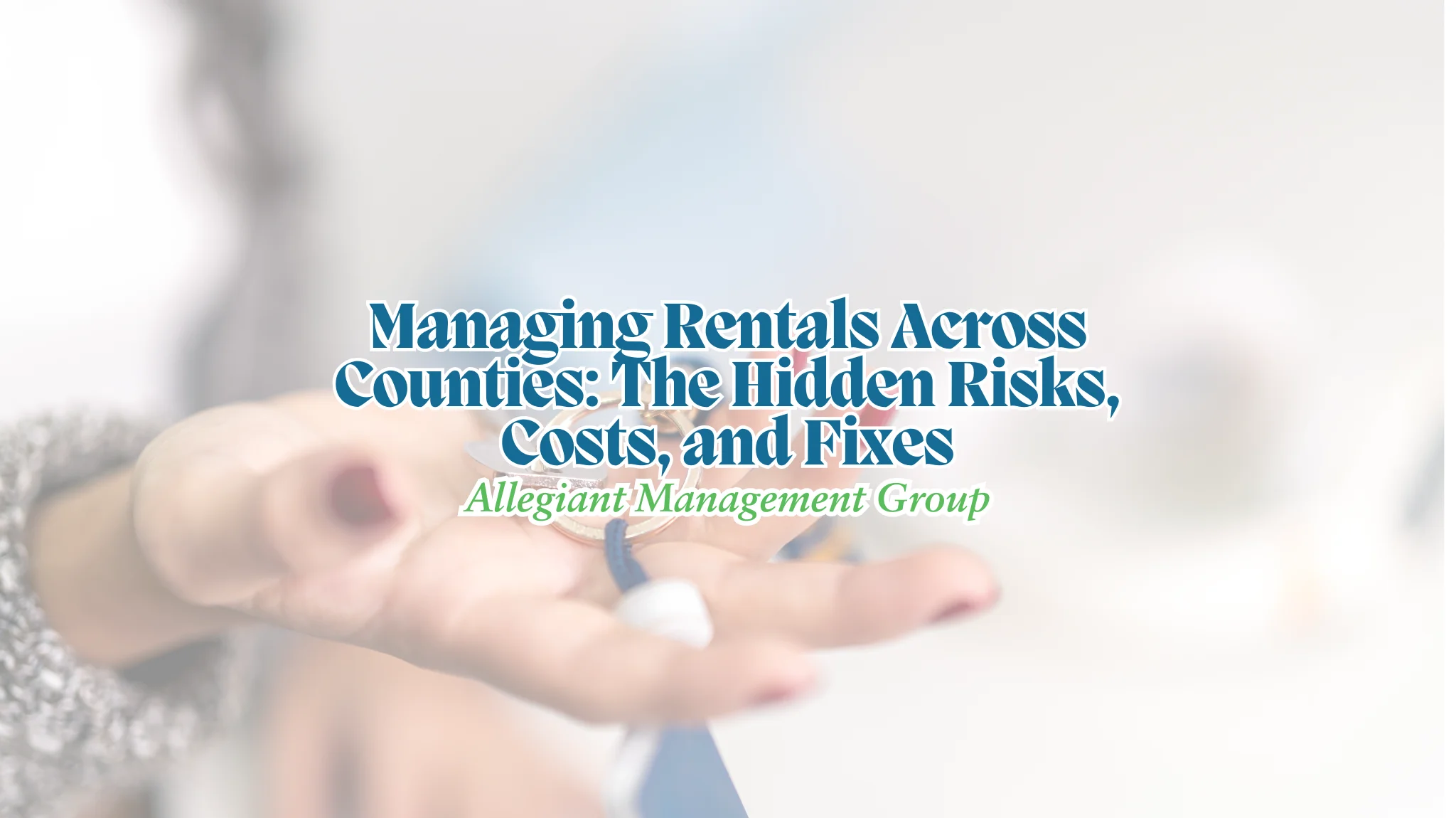Managing properties across multiple counties can quickly become complex. Different rules, added costs, and stretched resources can impact your bottom line. This guide helps property managers uncover hidden risks, streamline operations, and scale confidently while maintaining great tenant experiences.
The Legal & Regulatory Maze
Landlord–Tenant Rules & Evictions
Every county may have its own notice periods, filing steps, and court timelines. Create fact sheets for each area outlining notices, service methods, and required forms. Have legal counsel review updates regularly.
Rent Control & Local Ordinances
Some counties or cities limit rent increases or require relocation assistance. Track which properties are affected and set your software to flag increases that exceed local rules.
Licensing, Registration & Inspections
Many jurisdictions need rental licenses or periodic inspections. Keep a calendar with reminders and store inspection reports and corrective tasks in one place.
Fair Housing Laws
Local rules may add protections beyond federal and state laws. Train your team on marketing, screening, and reasonable accommodation requirements specific to each area.
Zoning, Building & Safety Codes
Permits and certificates of occupancy vary by county. Maintain digital binders for each area with approved plans, permits, and inspection results.
- Do a legal audit every year, plus a mid-year spot check.
- Create county fact sheets for notices, fees, and forms.
- Keep a change log with effective dates and staff sign-offs.
- Version all templates by jurisdiction.

Operational Challenges
Maintenance & Repairs
Build local vendor lists with clear service windows and standards. Use SLAs to track timelines and require photo proof for completed jobs.
Tenant & Team Communication
Centralize all messages—calls, emails, texts, and portal notes—into one timeline per property. Use escalation rules for missed SLAs and multilingual templates for key messages.
Inspections & Oversight
Use standardized checklists and require timestamped photo or video proof. Route any issues automatically for follow-up and resolution.
Emergency Response
Plan coverage maps for after-hours issues. Keep spare parts in local storage and backup vendors for critical trades like plumbing and HVAC.
Financial & Administrative Controls
Property Taxes & Assessments
Track due dates, assessment changes, and appeal windows per county. Forecast tax impacts on your portfolio’s NOI.
Accounting & Reporting
Use property-level financial reports with a portfolio dashboard. Keep GL codes, vendors, and job names consistent across counties for accurate comparisons.
Insurance & Risk Management
Align coverage by local risk type—flood, fire, or freeze. Keep claims playbooks and vendor pre-approvals for faster recovery.
Staffing & KPIs
Use centralized teams for admin tasks and regional leads for field operations. Measure both response speed and quality of resolution.
Standardizing Your Systems
Core SOPs
- Make-ready and turn checklists with clear standards.
- Defined work order stages: triage → dispatch → QC → closeout.
- Vendor intake process with COIs, licensing, and background checks.
- QA sign-off with photo proof and tenant confirmation.
Localized Add-Ons
Append county-specific requirements to your master SOPs instead of reinventing separate versions.
Training & Certification
Build role-based training modules with short quizzes and annual refreshers on fair housing, safety, and local laws.
Technology Tools That Help
All-in-One Platforms
Look for software with built-in leasing, maintenance, accounting, and document storage—plus automated reminders.
Vendor Management
Track insurance and licenses, rate performance, and rotate jobs to avoid single-vendor dependency.
Communication Hub
Use an omnichannel inbox that tracks all tenant interactions and triggers alerts for overdue tasks.
IoT & Remote Monitoring
Install leak sensors and smart locks for vendor access. Early alerts help minimize damage and costs.
Analytics & Dashboards
Monitor key metrics across counties: response times, first-time fix rates, rent variances, and tax or insurance trends.

Downloadable Checklists
County Compliance Playbooks
| Item | Owner | Frequency | Proof/Notes |
|---|---|---|---|
| Rental license/registration on file | Compliance | Annual/as required | License #, expiry |
| Inspection passed / re-inspection scheduled | Ops | Per program | Report ID, fail items fixed |
| Rent rules mapped (caps, notices, exemptions) | Legal | Quarterly | County fact sheet updated |
| Fair housing training with local add-ons | HR/Legal | Annual | Certificates stored |
| Required postings and disclosures | Ops | Semiannual | Photo proof |
| Zoning/CO/habitability docs current | Ops | Annual | Digital binder link |
Operations Checklist
| Process | Target | Measure | Escalation |
|---|---|---|---|
| Urgent ticket response | < 15 min | Time-to-acknowledge | On-call rotation |
| Non-urgent dispatch | < 24 hrs | Time-to-dispatch | Backup vendor auto-assign |
| First-time fix rate | > 85% | Closeout survey | Tech retraining |
| Inspection cadence | Per SOP | Compliance % | Regional lead review |
| Make-ready cycle | < 7 days | Turn time | Turn taskforce |
| Comm. SLA (tenant) | < 4 hrs | Unread age | Escalate to manager |
Entering a New County (30–60–90 Day Plan)
- Days 1–30: Research rules, licenses, inspections, and rent laws; draft fact sheet and vendor list.
- Days 31–60: Add data to SOPs, update software settings, train staff, and onboard vendors.
- Days 61–90: Run a mock audit and correct any gaps.
Emergency Response
- Activate emergency contact lists and vendor routes.
- Notify tenants with safety info and claims guidance.
- Deploy IoT monitoring and track issue status daily.
Audit & Remediation
- Identify issues and assign owners with deadlines.
- Upload photo proof and close tasks after review.
- Update SOPs to prevent repeat issues.
Frequently Asked Questions (FAQs)
What changes between counties?
Expect differences in rent limits, notices, licensing, and inspections. Keep a shared SOP with local add-ons.
Do I need separate rental licenses?
Usually, yes. Track each license’s ID, fee, and expiration date.
How can I standardize inspections?
Use one master checklist with local add-ons, and store results centrally.
Which software features matter most?
Look for multi-property accounting, work orders, online payments, and compliance tracking.
How do I build a vendor network across counties?
Prequalify by county, verify licenses and insurance, and track performance after each job.
Conclusion
Managing properties in several counties doesn’t have to be overwhelming. The key is simple: standardize your SOPs, localize where needed, and use technology to stay compliant. With the right structure, you’ll lower risk, improve response times, and strengthen tenant satisfaction—all while protecting your bottom line.



